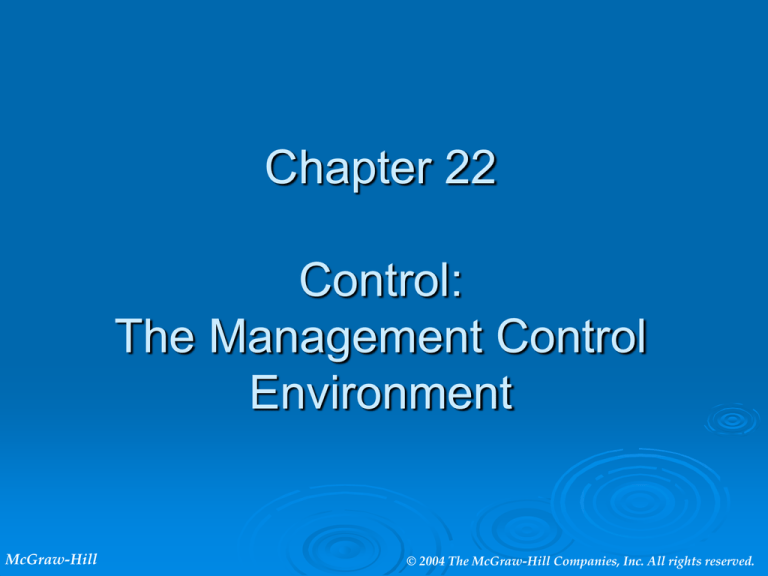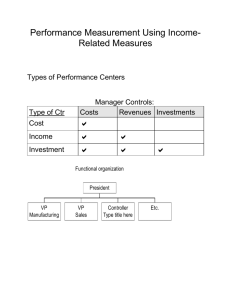
Chapter 22
Control:
The Management Control
Environment
McGraw-Hill
© 2004 The McGraw-Hill Companies, Inc. All rights reserved.
Management Control
This
chapter addresses the control
process and the use of accounting
information in that process.
The activity “strategy formulation”
develops strategies to attain an
organization’s goals.
Strategies change whenever a new
opportunity or a new threat is perceived.
22-2
Management Control Process
Process
by which managers influence
members of the organization to implement
the organization’s strategies efficiently and
effectively.
Takes goals and strategies as given.
Seeks to assure that the strategies are
implemented.
Includes planning.
22-3
Two Parts of Planning
A statement
Resources
of objectives.
required to achieve those
objectives.
22-4
Goals and Objectives
Terms
often used interchangeably.
Goals = broad, usually non-quantitative,
long run plans relating to the organization
as a whole.
Objectives = more specific, often
quantitative, shorter run plans for
individual responsibility centers.
22-5
The Environment
Four
facets of the management control
environment:
Nature of organizations.
Rules, guidelines and procedures that govern
the actions of the organization’s members.
The organization’s culture.
External environment.
22-6
The Nature of Organizations
Organization:
a group of human beings
who work together for one or more
purposes.
Managers
or the management: Leaders
who perform important tasks.
22-7
Tasks of Management
Determining goals.
Determining objectives to achieve the goals.
Communicating goals and objectives.
Determining tasks to be performed to achieve
objectives.
Coordination.
Matching individuals to tasks.
Motivating.
Observing/monitoring employee performance.
Taking corrective action as needed.
22-8
Organization Hierarchy.
= Layers of management with authority running from top
to bottom.
Optimal number of subordinates: (10?)
Organization chart.
Line units their activities are associated with achieving
the objectives of the organization. (They produce and
market goods or services.)
Staff units exist to provide support services to other
units and to the chief executive officer (CEO).
22-9
Rules, Guidelines, and
Procedures
Influence
Written,
the way members behave.
or verbal; formal, or informal.
22-10
Culture
Norms
of behavior determined by:
Tradition.
External influences.
Attitudes of senior management and the
board of directors (BOD).
22-11
External Environment
Everything
outside of the organization
itself.
E.g.,
customers, suppliers, competitors,
regulatory agencies.
22-12
Responsibility Accounting
Involves
a continuous flow of information
that corresponds to the continuous flow of
inputs into, and outputs from, an
organization’s responsibility centers.
Usage of various resources are measured
directly in or converted to a monetary
measure.
Focuses on responsibility centers.
22-13
Full Cost Accounting
Focuses
on goods and services.
Responsibility
accounting is a different
ways of slicing the same pie.
22-14
Responsibility Centers
Commonly
perform work related to several
products.
Inputs
to a responsibility center are called
cost elements or line items (on a
department cost report).
Costs
have three different dimensions:
22-15
Dimensions of Costs
Responsibility
center. Where was cost
incurred?
Product
dimension. For what output was
the cost incurred?
Cost
element dimension. What type of
resource was used?
22-16
Effectiveness and Efficiency
Effectiveness
= how well the responsibility
center does its job.
Efficiency
= the amount of output per unit
of input.
Lower
cost is more efficient.
22-17
Limitations of Actual Costs
Compared to Standard
Not
an accurate measure of efficiency for
at least 2 reasons:
Recorded costs are not precisely accurate
measures of resources consumed.
Standard are at best only approximate
measures of what resource consumption
ideally should have been in the circumstances
prevailing.
22-18
Types of Responsibility Centers
Important business goal: earn a satisfactory
return on investment:
ROI = (Revenues - Expenses) / Investment
Leads to 4 types of responsibility centers:
Revenue centers.
Expense centers.
Profit centers.
Investment centers.
22-19
Revenue Center
Responsible for outputs of center as measured
in monetary terms (revenues).
Not responsible for the costs of goods or
services that the center sells.
E.g., sales organization.
Also responsible for selling expenses (e.g.,
travel, advertising, point-of-purchase displays,
sales office salaries, rent).
22-20
Expense Centers
Responsible
for expenses (i.e., the costs)
incurred but does not measure its outputs
in terms of revenues.
E.g., production departments, staff units
such as accounting.
22-21
Standard or Engineered Cost
Center
Expense
center for which many of its cost
elements have standard costs established.
Differences
between standard costs and
actual costs are variances.
E.g.,
production cost centers, fast food
restaurants, and blood testing laboratories.
22-22
Discretionary Expense Center
Also
called managed cost center.
Difficult
to measure output in monetary
terms.
Production
E.g.,
support and corporate staff.
human resources, accounting, R&D.
22-23
Profit Centers
Performance
measured as difference
between revenues and expenses.
E.g.,
independent division of a company,
factory that sells its output to the
marketing division.
22-24
Advantage of Profit Center
Encourages
managers to act as if they are
running their own business.
22-25
Criteria for Profit Center
Involves extra record keeping.
Only useful if manager influences both revenues,
and costs.
If senior management requires service performed
by other responsibility center at no charge, then not
a profit center, e.g., internal audit.
If output is homogeneous (e.g., tons) no advantage
to monetary measure of revenue.
Multiple profit centers creates spirit of competition.
22-26
Transfer Prices
Price
at which goods or services are sold
between responsibility centers within a
company.
Revenue for selling center and cost for the
receiving center.
2 general types of transfer prices:
Market based price.
Cost based price.
22-27
Market-based Transfer Prices
Based
on price for same product between
independent parties, i.e., a market price or,
equivalently, an arm’s length price.
Adjusted for quantifiable differences such as
credit costs.
Where available is widely used.
Frequently not available.
22-28
Cost-Based Transfer Prices
When
Cost
no reliable market price is available.
plus a mark-up.
If
based on actual cost, little incentive to
reduce costs.
22-29
Transfer Pricing Issues
Negotiated
by responsibility centers or
set/arbitrated by top management.
Should
manager have freedom to use
alternative source?
Sub-optimization:
maximize profits for a
responsibility center may not maximize
profit for the consolidated company.
22-30
Investment Center
Responsible
for use of assets as well as
profits.
Expected
to earn a satisfactory return on
assets employed in the responsibility
center.
22-31
Measures of Performance
Return
on investment = Profit/Investment
Return
on assets = (net income) / (total
assets).
Split between ROS and Asset Turnover
income = Pre-interest profit –
(Capital charge * investment)
Residual
22-32
Residual Income
Residual
income = Income before taxes
less a capital charge.
Capital
charge is calculated by applying a
rate to the investment center’s assets or
net assets.
22-33
Advantage of Residual Income
over ROI
Encourages
managers to make all
investments whose return is greater than
the capital cost rate.
Example
22-34
Advantage of ROI Over
Residual Income:
ROI
measures are ratios that can be used
to compare investment centers of different
sizes.
Residual
income is an internal number that
is not reported to shareholders and other
outsiders.
22-35
EVA - overview
EVA is simply annual operating profit after-tax--minus a special charge for
the cost of capital. That charge corrects a glaring loophole in standard
accounting. In financial statements, companies pay nothing for equity
capital. It looks like free money. But equity is really very expensive. To raise
money from investors, companies must return at least as much as
shareholders could earn from a basket of stocks with the same risk--say,
12% a year. That's the cost of equity capital. If the company doesn't earn at
least its capital cost (blended to include the cost of debt), it can't keep
attracting new investment.
Far from being new, EVA, in effect, is one of the long- standing pillars of
finance theory: Until a company posts a profit greater than its cost of capital,
it's not making money for shareholders, no matter how good accounting
earnings look.
EVA is changing not only how managers run companies, but the way Wall
Street prices them. In the past three years, Credit Suisse First Boston and
Goldman Sachs have instructed their analysts to de-emphasize measures
like earnings per share and return on equity in favor of EVA
22-36
EVA Calculations - Part 1
To figure a company's or operation's economic value added, you must know two
things: the true cost of capital and how much capital is tied up. Here's a short guide to
get you on your way. Most companies pay for two kinds of capital, borrowed and
equity. It's easy to figure the cost of your borrowed capital--it's simply the interest rate
your banks and bondholders charge. But equity capital, the money stockholders
provide, is tricky. Although you don't have to write a check for it, don't think it's free.
The true cost is what your shareholders could be earning elsewhere.
To get that figure, you need to know that shareholders generally earn about six
percentage points more on stocks than on government bonds. With long-term
treasury rates around 7.5%, your cost of equity would be about 13.5%--more if you're
in a riskier than average industry. Assuming you use debt as well as equity capital,
the overall cost is the weighted average of the two.
22-37
EVA Calculations - Part 2
Now you need to figure out how much capital is tied up in your
business. That includes buildings, machines, and computers.
But there's more. What about investments in R&D or training?
Those are meant to pay off over the long haul, but accounting
rules say you have to write them off all at once. Forget the
accounting rules. Treat them as capital, and give them a useful
life. If, say, you're spending $20 million developing new products
this year, add that to your capital base, and add it back to
operating profits. If you expect the product to have a five-year
life cycle, deduct $4 million a year from capital--and operating
profits--in each of the next five years.
Now get out your calculator. Multiply your total capital by your
weighted average cost of capital. Compare that figure with your
after-tax operating earnings. If they are greater than your cost of
capital, have a cigar. You've got a positive EVA, which means
you're creating wealth for your shareholders.
22-38
EVA - Summary
EVA is powerful and widely applicable because in the end it doesn't
prescribe doing anything. If it tried, it would inevitably run aground in certain
unforeseen situations. Instead it is a method of seeing and understanding
what is really happening to the performance of a business. Using it, many
managers and investors see important facts for the first time. And in
general, they validate EVA's basic premise: If you understand what's really
happening, you'll know what to do.
22-39
Investment Center Issues
Asset allocation between centers.
How to value assets (e.g., historical cost or
replacement cost).
Most companies control investments in fixed
assets using capital investment (i.e., capital
budgeting) procedures addressed in Chapter 27.
Managers focus their day-to-day efforts on
managing current assets, particularly inventories
and receivables.
22-40
Non-monetary Measures
Non-monetary
as well as monetary
objectives.
E.g.,
Quality of goods or services,
customer satisfaction.
Management
by objectives (MBO) and
Balanced Scorecards in Chapter 24.
22-41




